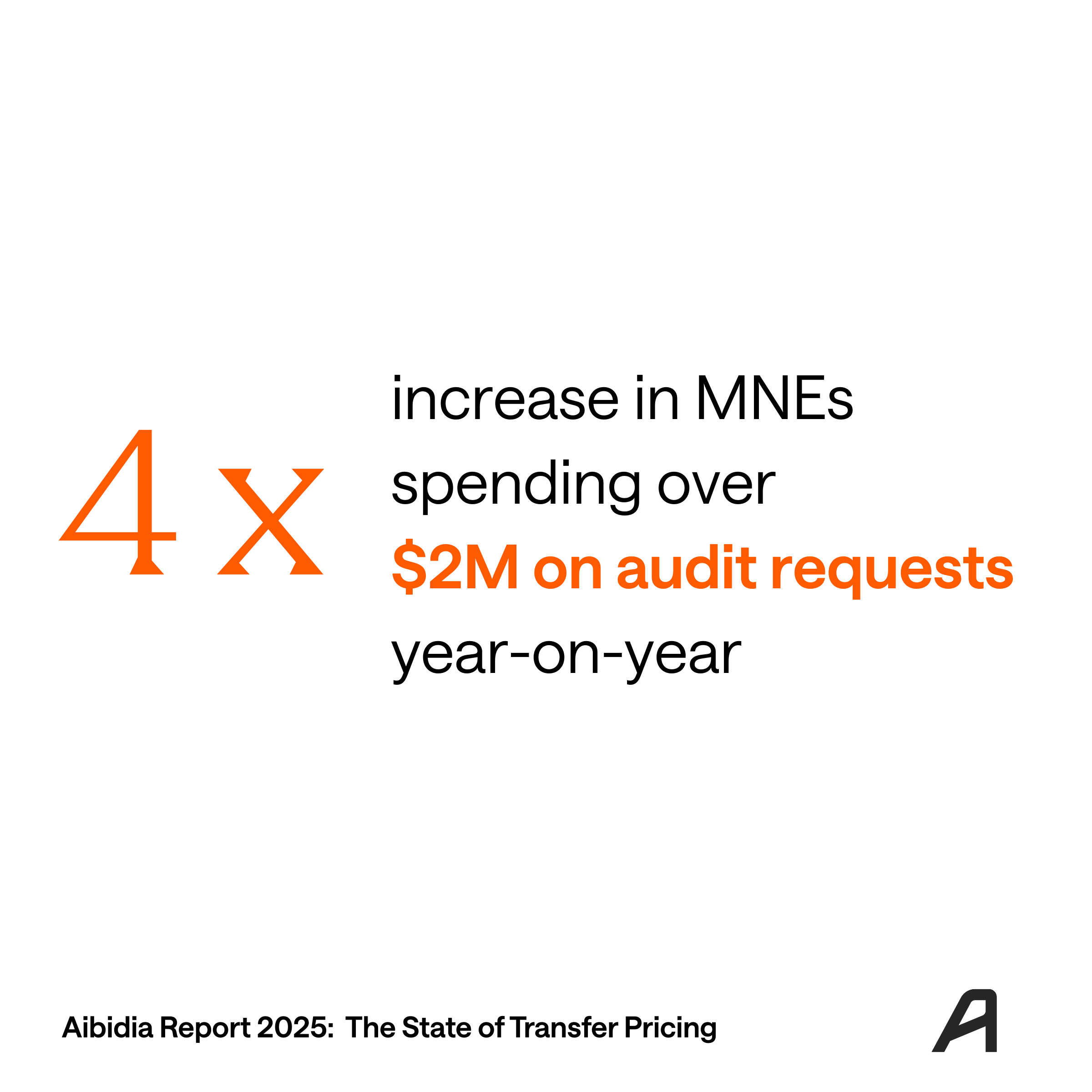Group cost allocation can be a difficult task. It requires a solid understanding of applicable transfer pricing regulations, as well as implementation resources (both in terms of technology and time). Therefore, the only way to minimize transfer pricing risk associated with the group cost allocation is to develop a transparent and consistent system that appropriately allocates service costs. We believe that this can be achieved through a digital transfer pricing platform like Aibidia, and in this post, we explain the basics of group cost allocation and the requirements for the system that would manage it, end-to-end.
What are intragroup services?
Service is a transaction in which no physical goods are transferred from the seller to the buyer. In other words, everything that does not involve the transfer of products is a service. OECD Guidelines define intra-group service as an activity (e.g. administrative, technical, financial, commercial, etc.) for which an independent enterprise would have been willing to pay or perform for itself.
Some services are so specific that they are addressed separately by the OECD Guidelines (for example, financial transactions).
Cross-border, intra-group service transactions are especially challenging to assess. Unlike tangible goods, services are not observable at a country's borders. For tax administrations, it may be challenging to measure and evaluate these transactions, and they often see intra-group services as tax avoidance instruments.
An additional level of complexity is added because MNEs tend to centralize some of their functions, such as accounting, IT, HR, and procurement. Therefore, proper allocation of centrally borne costs related to these functions is a particular issue from financial and tax perspectives.
Centralized and shared services models
Most MNEs prefer structuring their organizations with some level of centralization. A centralized MNE organization that sits within a headquarter company may execute control over all material financial matters of its subsidiaries (global centralization). Alternatively, regional head offices may control the subsidiaries' finances within the region (regional centralization). In contrast, the traditional (or decentralized) model assumes that the subsidiaries themselves execute this function.
Another popular model of centralized organization is a service center. A shared services center is an entity responsible for executing and handling specific operational tasks, such as human resources, accounting, payroll, legal, IT, compliance, procurement, and security. A shared services centre is often a spin-off of the corporate services, separating all operational tasks from the corporate headquarters, which focuses on leadership and corporate governance roles. As shared services organizations are cost centers (i.e., they do not generate revenue and profit for MNEs), they are quite cost-sensitive in terms of their headcount, labour costs and location selection criteria. In other words, shared service centres are internal outsourcing organizations. An MNE that decides to outsource accounting activities may have a trade-off between third party outsourcing and internal outsourcing via creating a shared service centre.
Decentralized services and cost contribution arrangements
Often, teams providing services within MNE sit in different legal entities and organizational units of the group. This is where more complex group cost pooling and allocation models may be required. It can often take the form of services cost contribution arrangement (CCA), which has several advantages over traditional intra-group service arrangements in terms of administration. Where multiple MNE group members provide services to each other, arranging a web of separate intra-group agreements and payments can be burdensome. As an alternative, there can be one arrangement that allows services to be provided to each other. Such services arrangement (often taking the form of services CCA) can be especially useful when multiple teams are spread around the MNE group and cross-support other entities, e.g., the same entities act as service providers and recipients.
Each line in the illustration below shows the flow of services. Accordingly, under the standard intra-group service arrangement, every line will correspond to a separate flow of charges and a separate service agreement.

Under a group services cost allocation framework (or CCA), there is the possibility of pooling services costs in one bucket, and then allocating them to participants:

In such a model, service costs can be pooled and allocated either by one of the participants, or by a separate entity acting as a facilitator and coordinator of the framework.
Cost pooling and cost allocation
In the intragroup environment, almost every service model would require cost pooling and cost allocation. At Aibidia, we call this end-to-end framework a group cost allocation.
A cost pool is a grouping of individual costs, typically by department or service center. Cost allocations are then made from the cost pool. For example, the cost of the maintenance department is accumulated in a cost pool and then allocated to those departments using its services. This process can happen just within one legal entity or involve several legal entities simultaneously.
Note that cost pooling and cost allocation are not transfer pricing concepts per se but rather accounting concepts. As mentioned earlier, cost pooling and cost allocation can work within one company and may not involve intragroup transactions.
However, what makes the process important from a transfer pricing perspective is that it should be structured to ensure a proper match of costs and benefits within the group. The arrangement and framework must lead to arm's length results.
Transfer pricing example
On a high-level, group cost allocation involves the following steps:
- Identification of costs to be pooled in cost centers.
- Pooling these costs in identified cost centers.
- Identification of beneficiaries of costs.
- Allocation of costs to beneficiaries.
Imagine three HR managers working in multinational Group A. They are located in Finland, Poland and India and are employed by local subsidiaries of Group A. However, they are working in global roles, i.e. they support Group A's global HR function and perform activities for all Group A's entities worldwide (imagine there are 20 countries and therefore 20 subsidiaries). We can use the development of Group A's Global Annual Leave policy as an example of an HR activity that benefits all Group A's entities.
From a transfer pricing substance perspective, Group A Finland, Group A Poland and Group A India provide HR services to all 20 Group A's subsidiaries, i.e. 3*20 transactions are happening. This adds a lot of complexity from an accounting, invoicing and contracting perspective.
Therefore, Group A uses group services cost allocation framework to minimize contracting and invoicing complexity.
Therefore, Group A would:
1.Determine direct and indirect costs of the HR services provided by Group A Finland, Group A Poland and Group A India. For example:
2. Pool these costs in one cost pool ("cost center”), usually within one dedicated entity (sometimes referred to as “coordinator”). For example, let's assume there is a dedicated Group A entity acting as a coordinator in the Netherlands.

- Determine the beneficiaries of these HR services. Let's assume all 20 subsidiaries of Group A are benefiting from these HR services.
- Determine the best way to allocate costs. This process usually includes the determination of the allocation key. For example, in the case of HR services, the headcount (number of employees) is often used as an allocation key.
- Collect information about allocation key values for beneficiaries, calculating the proportion, and cost allocation:

As an outcome, every group company that benefits from the service receives an appropriate cost allocation charge. Note that in this example, services are provided at cost, i.e. without mark-up, while in practice, service providers would usually add a profit element in their recovery charge.
What should the ideal group cost allocation system look like?
At Aibidia, we develop transfer pricing applications that help companies manage their transfer pricing end-to-end. Since group cost allocation is critical for almost every MNE, we couldn't ignore it. So here are the key requirements that we listed when we started developing the app:
- Cost pooling - the solution should help users create a cost center structure, map cost centers to particular services, aggregate cost elements under cost centers, and issue recovery invoices for service providers.
- Cost allocation - the solution should define allocation keys (and, ideally, help users to select proper ones), map them to services or cost centers, populate allocation key values per legal entity, and automatically calculate allocation shares. It should consider mark-ups, third-party costs, shareholder activities, and other exceptions. In the end, it should issue allocation invoices.
Additionally, we wanted our solution to help with benefit test, automatically recognize and map costs to cost centers, and suggest a draft legal framework. And since we are a digital transfer pricing company, we had to ensure that the solution would be data-driven and integrated with our ecosystem. This effectively means that:
- Data import and export features have to be there. Group cost allocation process is usually executed monthly, and we need to give users an effective way to import cost and allocation key data, easily.
- The solution should communicate with other Aibidia applications. For example, group cost allocation results should flow to Aibidia's Digital TPDoc, and local files for services transactions should be automatically generated.
- Analytics. There is a lot of group cost allocation data, and we want to give users insights into what is happening in their framework. That would enable the company to take the efficiency of its allocation system to a different level - by proactively managing its costs and mitigating tax risks.
In summer 2022, we launched the Alpha version of Aibidia’s Group Cost Allocation (GCA), and at the beginning of 2023, we have a fully operational Beta that our customers start using.
Streamline Your Group Cost Allocation with Aibidia: How Does it Work?
Aibidia’s GCA provides a seamless process to help multinationals allocate their costs effectively and efficiently. Here’s how it works:
- Model Setup: This is where the parameters of the group cost allocation are set, such as the period, scope, entities, and their roles. This ensures that the cost allocation process is aligned with the company’s business objectives and structure.
- Data Input: The next step is to input the cost elements and allocation key values data. This can be done easily and efficiently, thanks to the user-friendly interface of the Aibidia GCA solution and Aibidia’s Data Studio.
- Allocation: With the data in place, it’s time to execute the cost allocation. This is where the GCA solution uses advanced algorithms to distribute costs accurately and fairly across different entities.
The output of the GCA process includes:
- Reporting: The solution generates custom reports that provide a clear and concise overview of the cost allocation process. This allows companies to track their costs and make informed decisions, generate invoices and prepare management information.
- Invoicing & Supporting Documentation: The GCA solution issues invoices and creates supporting documentation to defend charges. This helps companies avoid disputes and minimize the risk of overspending.
- Analytics: This is where the GCA solution truly shines. The analytics features provide valuable insights into costs, allocations, and trends over time. This helps companies identify areas of improvement, optimize their operations, and make better use of their resources.
To summarize, the Aibidia GCA solution streamlines the complex and time-consuming task of cost allocation, helping companies save time and money, reduce risks, and make better business decisions.

How does Aibidia’s GCA analytics improve compliance, efficiency, and decision-making?
The Aibidia Group Cost Allocation (GCA) solution has analytics features to provide insights into cost structures and flows. These analytics help users understand their cost allocation and transfer pricing more thoroughly, and identify potential risks and areas for optimization.
The benefits of these analytics features are:
- Increased transparency: The analytics provide a clear picture of cost structures and flows, helping users to identify areas of concern and opportunities for improvement.
- Enhanced compliance: The analytics help users achieve full compliance with the arm’s length principle by providing a detailed understanding of transfer pricing risks and providing the necessary documentation to support their decisions.
- Improved decision-making: The insights provided by the analytics enable users to make informed decisions on cost allocation, transfer pricing, and tax optimization.
- Reduced risk: By providing a better understanding of cost structures and flows, the analytics reduce the risk of overspending, human error, and negative outcomes in tax audits.
- Improved efficiency: The analytics streamline the process of cost allocation, reducing the time and resources spent on manual calculations and improving the accuracy of results.
Overall, the analytics features in the Aibidia GCA solution help users make informed decisions, improve transparency, enhance compliance, reduce risk, and improve efficiency. The ultimate goal of Aibidia’s GCA analytics is to provide the next level of visibility and control to transfer pricing professionals.
If you are interested in seeing our group cost allocation solution - please reach out to us!





%20(2).png)



.png)

.png)
.png)






.svg)
